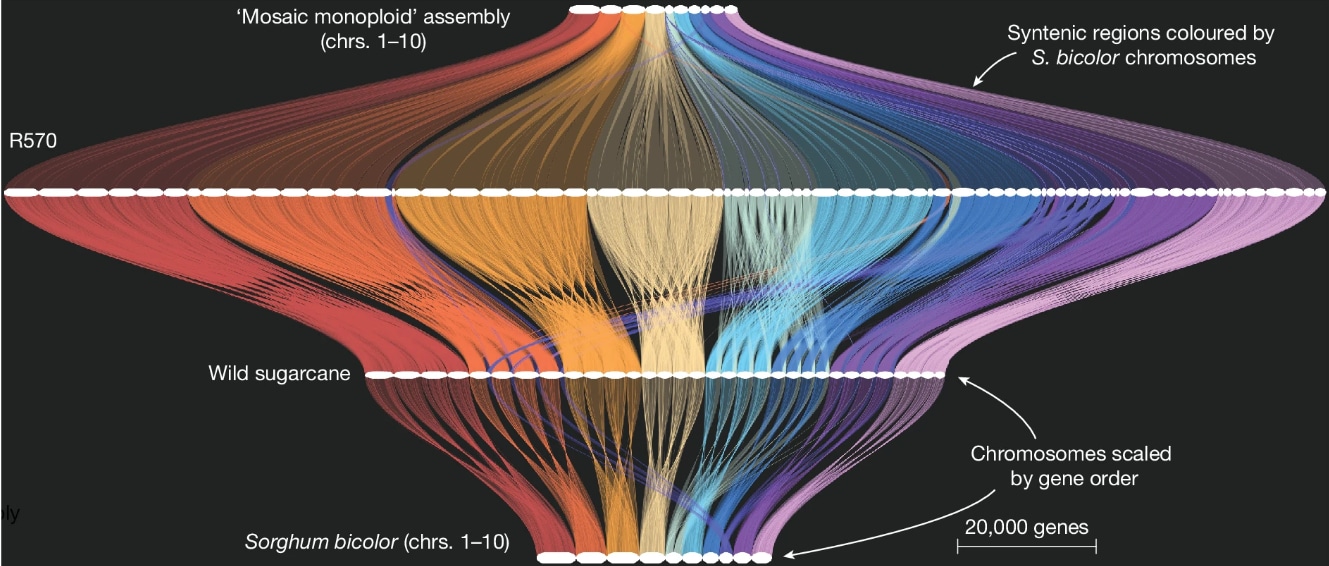
PacBio HiFi sequencing technology continues to be the tool of choice for genomics professionals working at the forefront of discovery, enabling them to pursue new avenues of exploration across diverse domains of biology.
In this edition of our Powered by PacBio blog series, we highlight scientific papers from the month of April 2024. These compelling preprints and publications highlight the power of PacBio sequencing to sequence sugarcane, uncover isoform diversity of great apes, reveal splicing patterns in developing adult mouse and human brains, and more.
Jump to topic:
Paraphase Agrigenomics Y chromosome Splicing patterns
Paraphase
Genome-wide profiling of highly similar paralogous genes using HiFi sequencing
In this preprint, researchers from PacBio, GeneDx, CMKC, U of MO, Genomics England UK, Radboud Netherlands, Children’s National, UC Irvine describe the use of Paraphase as “…a HiFi-based informatics method that resolves highly similar genes by phasing all haplotypes of a gene family”.
Key takeaways:
- Segmental duplications are “a gene-rich portion of the genome previously considered largely inaccessible” which “became blacklisted from SNV analyses because short-read sequence data could not be uniquely placed”, despite being more variable than unique regions: “SNV density is significantly elevated (60%) in duplicated DNA when compared to unique DNA.”
- This study “applied Paraphase to 160 long (>10 kb) segmental duplication regions across the human genome with high (>99%) sequence similarity, encoding 316 genes.”
- Population analysis revealed highly variable copy numbers of these regions, 23 gene families with exceptionally low within-family diversity, 7 de novo SNVs and 4 de novo gene conversion events, 2 of which are non-allelic.
- They characterized “extensive genetic diversity in 46 medically relevant genes previously considered challenging to genotype” (including SMN1/SMN2).
- Conclusion: “Paraphase is “enabling accurate testing in medically relevant genes and population-wide studies of previously inaccessible genes.”
Agrigenomics
The complex polyploid genome architecture of sugarcane
In this paper, researchers from HAIB, France, JGI, Australia, Corteva, Czech Rep, U of AZ, LBNL present their work on likely the most complex genome ever assembled.This marks a “major step towards advancing sugarcane biotechnology by generating a polyploid reference genome of a modern sugarcane hybrid [R570].” The 8.7 Gb assembly “contains a complete representation of unique DNA sequences across the approximately 12 chromosome copies in this polyploid genome”.

Y chromosome
In this preprint, a team of scientists from Penn State in Germany used Iso-Seq data mapped to T2T assemblies for improved understanding of transcriptome complexity of Y chromosome ampliconic gene (YAG) families.
Key takeaways:
- They noted that “the invention of long-read sequencing … revealed the tremendous diversity of the transcriptome (Ren et al. 2023), which translates into proteome diversity (Park et al. 2018; Soto et al. 2019) … In the human genome, >90% of genes undergo alternative splicing (Wang et al. 2008) … Long sequencing reads … are essential to capture the differences between transcripts originating from highly similar copies within each YAG family.”
- During the study, Iso-Seq “was crucial to differentiate between transcripts originating from highly similar copies present within each YAG family.”
- Also saying, “For each gene family, we detected transcribed pseudogenes along with protein-coding gene copies. We revealed previously unannotated gene copies of YAGs as compared to currently available NCBI annotations, as well as novel isoforms for annotated gene copies.”
- Conclusion: “This analysis paves the way for better understanding Y chromosome gene functions, which is important given their role in spermatogenesis.”
Splicing patterns
In this formal publication of the preprint, researches from Weill Cornell, Spatial Genomics, Worcester Polytech, UCSC, Touro U, Rockefeller, and U of VA created a comprehensive brain isoform map for mouse & human through single-cell RNA isoforms across brain regions, cell subtypes and developmental time points, revealing “an unappreciated degree of isoform variability.”
Key takeaways:
- “For 72% of genes, full-length isoform expression varies along one or more axes.”
- “Splicing, transcription start and polyadenylation sites vary strongly between cell types, influence protein architecture and associate with disease-linked variation.”
- They observed “precise timing of splicing switches in maturation programs” which “justifies the need for simultaneous recording of gene expression and splicing.”
- The data revealed “showcase(s) the importance of long reads to capture a fuller picture of transcriptomic diversity in the brain and are available at www.isoformAtlas.com.”
- Important note: This study used Iso-Seq and Sequel II system – throughput and cost limitations are now addressed with the newer Revio system and Kinnex kits.
Ready to kickstart breakthroughs of your own?
These recent publications exemplify the versatility and power of PacBio sequencing. From tackling complex genomes like sugarcane to uncovering diversity in great apes, PacBio technology is enabling scientific pioneers to make transformative breakthroughs like never before.
PacBio sequencing is now more accessible for research teams of all sizes –thanks to new options for instrument financing or collaboration with certified service providers. To learn how to incorporate PacBio data into your next project:
Connect with a PacBio scientist